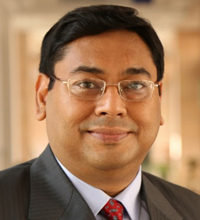
View this edition in our enhanced digital edition format with supporting visual insight and information.
What organizational configurations lead to the highest levels of innovation in family firms? In this week’s edition, which is a précis of “A Configurational Approach to Family Firm Innovation,” an article appearing in the June 2019 issue of FBR, Navneet Bhatnagar explores this question and its implications for family enterprise advisors.
Innovation is widely acknowledged to be a critical factor in ensuring competitive success, growth and long-term sustenance of family firms. Scholars have examined the antecedents of family firm innovation and established several direct relationships at the levels of individuals, firm, and the environment. However, in real life many of these antecedent factors often interact with each other but little is known about these inter-relations. This research theorizes and examines these direct and interaction effects on family firm innovation in a sample of 277 US-based family firms. The study employs ‘fuzzy-set qualitative comparative analysis (fsQCA)’ method, which allows for a fine-grained understanding of this phenomenon.
Family-Driven Innovation:
The family-driven innovation model captures firm heterogeneity in terms of innovation based on the owner family’s willingness and ability (i.e., implementation capability and resource availability) to innovate. The willingness factor reveals ‘where’ do they want the firm to go. This is captured by the family’s affective needs of identity, influence, and perpetuation of family dynasty – i.e., its socioemotional wealth (SEW). The ability in terms of discretion of implementation represents ‘how’ a family firm takes a specific strategic direction. Involvement of multiple generations and the level of professionalization captures this ‘how’ factor. Finally, the ability in terms of resources represents ‘what’ kinds of resources are needed for a family firm to take a specific strategic direction. The resource availability and requirements are largely determined by the environmental factors. Though individual relations between these factors and innovation have been conducted, this study shows how all these factors combine to influence family firm innovation.
Antecedents of Family Firm Innovation:
Drawing from the extant literature, the authors explore and theorize multiple antecedents of family firm innovation. The SEW objectives are known to influence family firm innovation but the effects of distinct SEW dimensions have not been empirically examined. Hence, the authors use the multidimensional SEW importance scale (SEWi) to probe the effect of SEW dimensions on innovation.
Firms with multiple generations are known to have high levels of innovation due to the ‘fresh momentum’ by young generations and enriched collective knowledge of the firm. However, later generation firms are also known to be less concerned for SEW and are more likely to professionalize. These complex interrelationships need to be examined further.
Professionalization fosters innovation as it brings-in outside experts with diverse knowledge. However, family firms are also known for not integrating non-family professionals as they prefer to keep the strategic control within the family to preserve SEW.
Finally, the authors theorize that the environment plays a significant role in determining family firm innovation. Firms under uncertain environments are known to be more innovative than those working under stable environments. Thus, several factors directly or in interaction with each other, affect the level of family firm innovation. This study seeks to identify those interaction effects.
Key findings:
The authors find that high levels of family firm innovation outcomes are achieved when SEW and intergenerational family involvement in business are high, but professionalization is low. Further, the authors also observe that different dimensions of SEW have varying effects on family firm innovation. More specifically, they find that when the ‘External SEW’ (i.e., the family’s desire for positive reputation and image) is more important for the family than the ‘Internal SEW’ (i.e., the family’s need to preserve family unity and control) then the family firm innovation is high. This happens because the passion to scale up the family’s reputation drives family members to innovate, which is also facilitated by the freedom they get from constrictions caused by professionalized control systems (as internal SEW is not considered overly significant in such family firms).
Combining the family, firm, and environment factors that drive innovation, the authors analyze 277 family firms and find six configurations that lead to high levels of innovation. These configurations are:
- Transgenerational innovators – These are the family firms where presence of later generation members increases knowledge diversity;
- Professionalized innovators – These are the firms in which non-family professionals bring in new knowledge and expertise that propels innovation;
- Adaptive innovators – These family firms operate in a munificent environment, have high SEW levels but lower generational involvement and professionalization;
- Family-embedded innovators – These firms operate in a dynamic environment, have high levels of SEW and generational involvement, but lack professionalization;
- Attentive innovators – These are the family firms that operate in a dynamic and munificence environment, have high levels of SEW and generational involvement, and
- Aggressive innovators – These family firms are driven by the concern to build and maintain reputation even when the environment is unfavorable, dynamic and resource constrained.
Readers are advised to refer to the ‘Discussion’ section of this paper for deeper understanding of the authors’ inductive theorizing.
Implications of the Study:
For Research
- This study implies that for understanding the antecedent effects on family firm innovation, examining the combined effect of professionalization and SEW is more logical than studying these as individual effects.
- The study extends the understanding of family firm innovation by establishing that the interaction effect of generational involvement and environmental dynamism on family firm innovation needs to be viewed in conjunction with the roles played by different SEW dimensions (i.e., internal and external SEW).
- Probing the predominant view in extant literature of positive effects of SEW, this paper shows that SEW can have a dual effect (negative and positive), on family firm innovation. The net effect on innovation is positive if a family firm assigns higher significance to external SEW than to internal SEW.
For Family Firms
- There is no single critical factor or path for family firms to achieve high levels of innovation. Varying combinations of SEW, professionalization, environmental dynamism/ munificence, and generational involvement result in six distinct configurations that could lead family firms to high levels of innovation. Therefore, to achieve high innovation a family firm must assess and adopt a configuration that best suits its resource and capabilities basket.
- Family firms that operate in a dynamic or generous environment and assign high importance to SEW can achieve high innovation levels in the absence of professionalization. In contrast, for family firms which operate in a static environment and do not assign much importance to SEW preservation, the presence of generational involvement or non-family managers is crucial to achieve high levels of innovation.
- Family firm managements need to be careful in making decisions relating to – (i) professionalization of business, and (ii) integration of later generation family members in the firm. When these decisions are made in alignment with the configurational requirements of the firm, it would lead to higher innovation.
For Advisors
- Family business advisors may help their client identify and build capabilities with respect to an organisational configuration that is appropriate for them to achieve higher levels of innovation.
- They need to help their clients achieve higher innovation by fine-tuning the degree of professionalization and the extent of later generation family members’ involvement. They must ensure that these are in tune with the significance the family attaches to external/internal SEW and the characteristics of the firm’s business environment.
About the Contributors
 Navneet Bhatnagar, PhD, CFBA is Senior Researcher at the Thomas Schmidheiny Centre for Family Enterprise, Indian School of Business, in Hyderabad, India. He can be reached at Navneet_Bhatnagar@isb.edu.
Navneet Bhatnagar, PhD, CFBA is Senior Researcher at the Thomas Schmidheiny Centre for Family Enterprise, Indian School of Business, in Hyderabad, India. He can be reached at Navneet_Bhatnagar@isb.edu.
About the Thomas Schmidheiny Centre for Family Enterprise, Indian School of Business
The Thomas Schmidheiny Centre for Family Enterprise was launched in 2015 with an aim to advance real-world and academic knowledge of family business. Since its inception, the Centre has been bringing together faculty and practitioners from India and abroad with the broad aim of combining theory and practice to enhance research and innovation in the field.

View this edition in our enhanced digital edition format with supporting visual insight and information.





